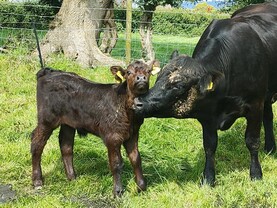Maximising the number of days that cows are at grass each year requires a flexible approach to grazing at Teagasc’s dairy research unit at Ballyhaise College in Co Cavan.
In general, the farm has mostly heavy clay soils and around 20% of the 40ha grazing platform is prone to flooding.
However, land type across the farm varies significantly from alluvial soils near a river to an area of clay soils on top of peat.
The 120-cow dairy herd began calving on 16 February and 90% of cows are due to calve within six weeks.
Average yield is around 5,100 litres and meal fed per cow ranges from 500kg to 700kg, depending on the type of year.
Dr Donal Patton from Teagasc told members of the Ulster Grassland Society during a visit last week that the main aim at Ballyhaise is to minimise input of bought-in feed and maximise use of grazed grass.
He said that three things are needed to allow early grazing on any farm; good grazing infrastructure, optimal soil fertility and a high proportion of rye grass in swards.
Measures such as on/off grazing, back fencing and 12-hour breaks are used on the farm when conditions are damp to get cows to grass while limiting poaching.
“Most years we get there, but we need some flexibility,” Donal said.
He said that many farmers on heavy soils could extend their grazing season, but a mindset that early grazing will damage land, create a grass shortfall or reduce milk yields stops them.
Measuring
Donal said that knowing if there is too much or not enough grass on the farm is central to making informed decisions about grazing and feeding.
He said that this can simply involve a weekly farm walk to roughly estimate covers in each paddock and does not necessarily require extremely accurate measurements or use of computer programmes.
Targets for average farm cover at key dates at Ballyhaise include 1,150kg DM/ha at the start of the last round on 25 September, 650kg DM/ha at housing in mid-November, 850kg DM/ha at turnount in mid-February and 500kg DM/ha at the end of the first round in mid-April.
“We change our management, but our targets stay the same,” Donal said.
Grass growth at Ballyhaise averages 13.7t DM/ha/year. However, this can vary from 11t DM/ha/year to 15.5t DM/ha/year depending on the year.
There is also a significant variation in grass growth between individual paddocks on the farm.
An area of particularly heavy soils can flood for several weeks at a time when an adjacent river overflows and annual growth here can range from 6t DM/ha/year to 12t DM/ha/year.
“We have to treat this part of the farm differently. If cows can walk on it and there is any grass, then we graze it off. We don’t build grass covers here for autumn grazing because it’s not reliable,” Donal said.
Grazing study
A study began at Ballyhaise last year to investigate the impact of both stocking rate and grazing season length on soils, swards, herd performance and profitability.
The dairy herd has been divided into four separate groups and a combination of two grazing season lengths (210 days and 270 days) and two stocking rates (2.5CE/ha and 2.9CE/ha) are being investigated.
The study will last three years and is a full-systems trial, meaning each of the four groups has been assigned equal proportions of the various land types on the farm.
The two groups on the extended grazing season got to grass on 19 February this year and the aim is for them to stay out until mid-November.
The first round for the extended grazing groups will last 60 days until mid-April when 30% to 40% of the platform will be closed for silage.
The shorter grazing season groups won’t get to grass until next week and will be housed at the end of October. Donal said that the challenge with turning cows out late is that there is too much grass on the platform by mid-April. The average cover on the shorter grazing season paddocks last week was 1,170kg DM/ha, which was around double the farm cover on extended grazing paddocks.
Fertility
The 120-cow herd is mostly high-EBI black and white cows, although there are some crossbred cows also. Calving used to run from January to June at Ballyhaise. However, in the mid-2000s, the decision was taken to tighten this by shortening the breeding season to 12 weeks and culling empty cows.
In 2017, the calving interval in the Ballyhaise herd was 368 days and six-week calving rate was 84%.
“It takes a good while to improve herd fertility and that’s with an aggressive approach to culling. It took eight years here to reduce empty rate from 36% to 10%,” Donal said.
He said that a compact calving block was the core principle at Ballyhaise, so that grass demand matches grass growth and only fertile cows are retained and breed replacements.
“When you are focusing on improving fertility, success breeds success, it gets easier and easier,” Donal said.
April farm walks
Farm walks are being held on three Dairylink Ireland project farms in counties Down, Tyrone and Cavan during April.
Topics, dates and locations are outlined at the bottom of the page.
Teagasc Ballyhaise is also hosting an open day on 5 April from 10am.
The theme of the event is technologies for resilient dairying.
Admission and parking at all events is free.






 This is a subscriber-only article
This is a subscriber-only article













SHARING OPTIONS: